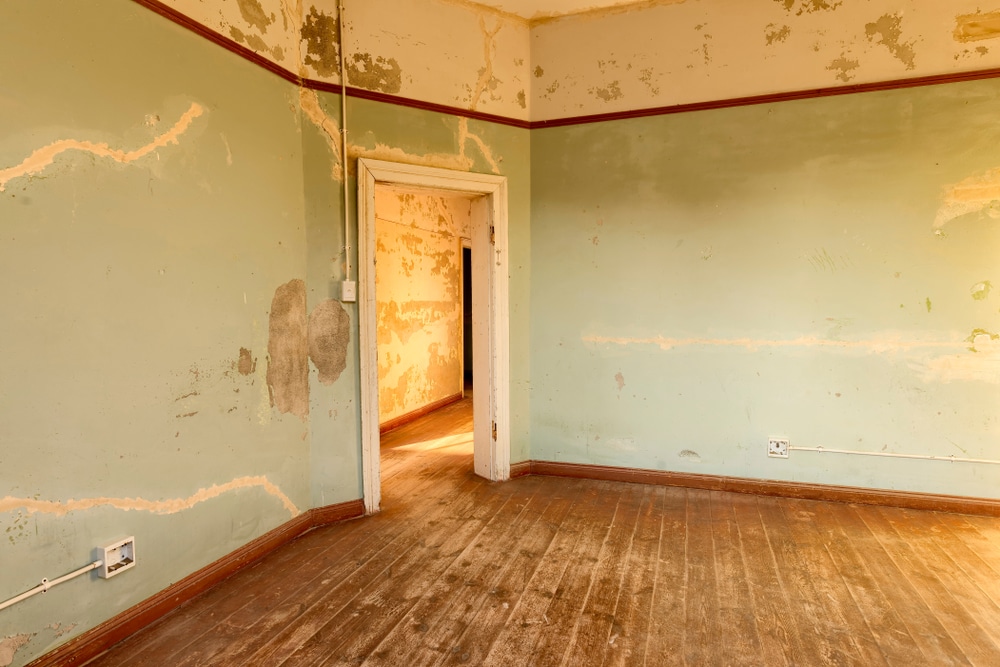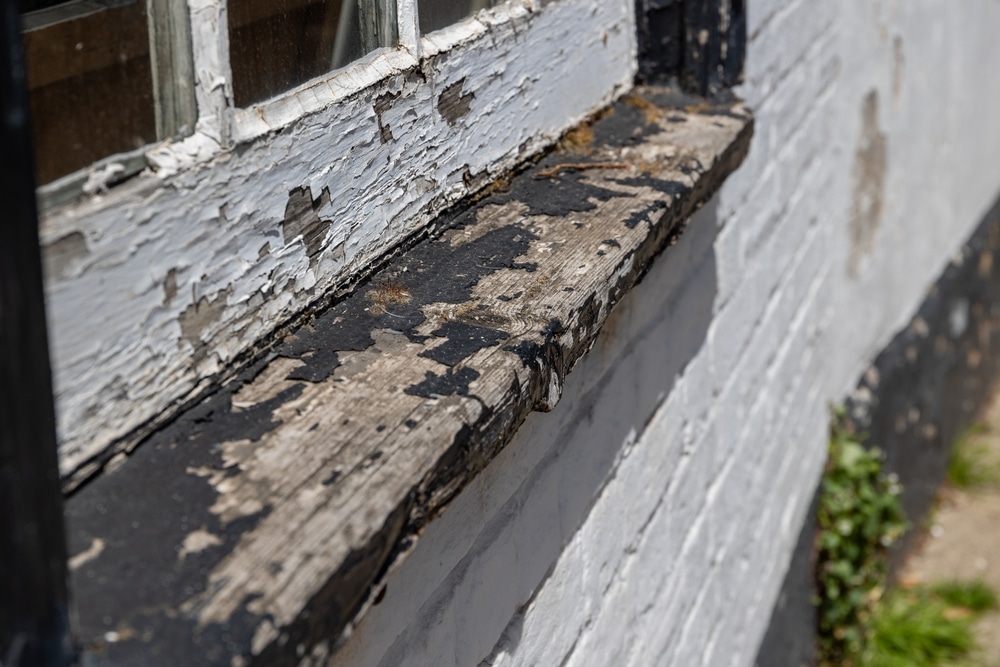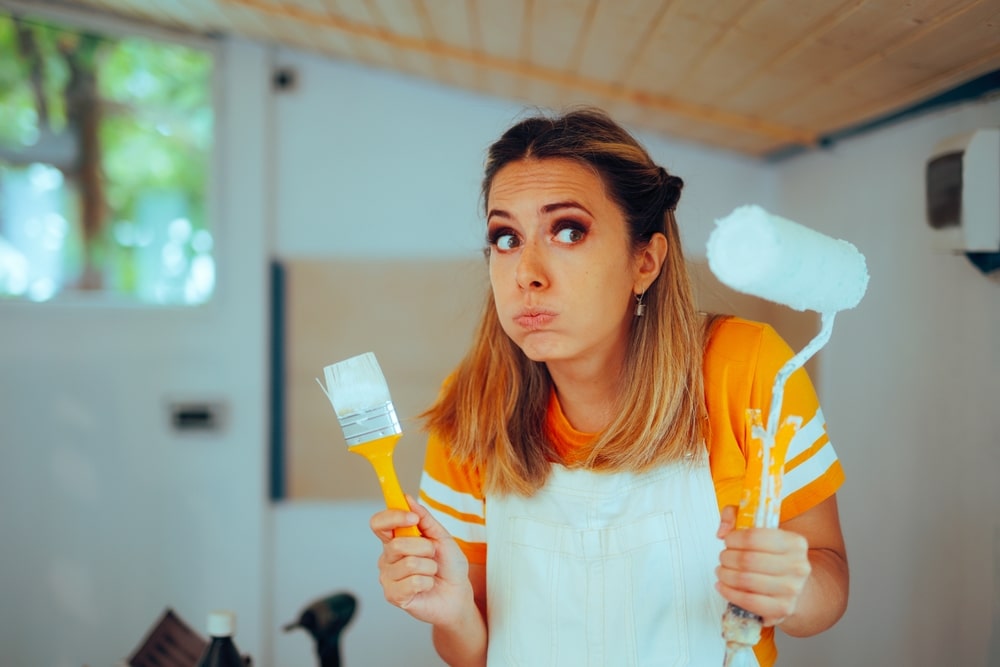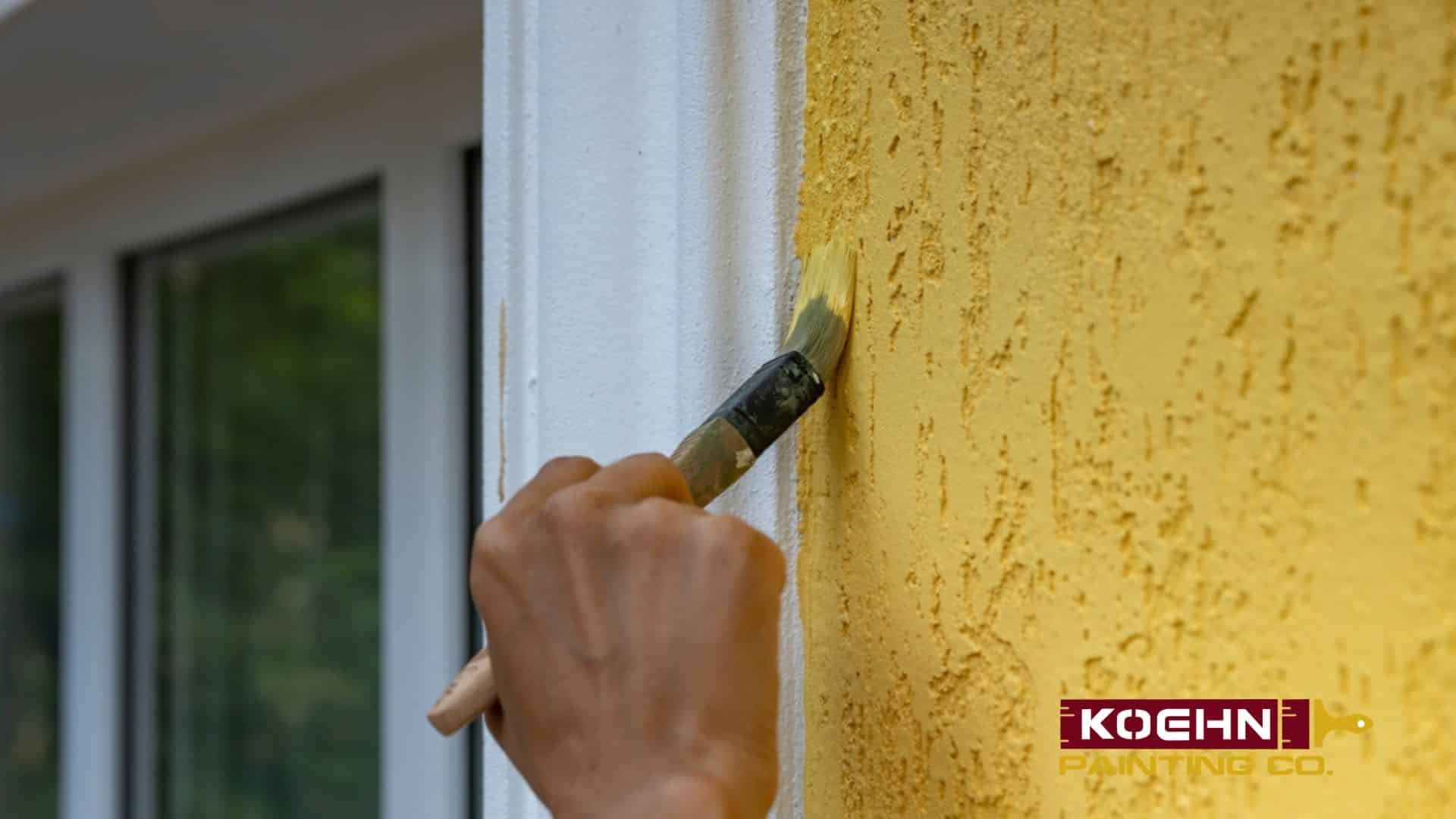Table of Contents
ToggleWhen it comes to painting projects, many homeowners ask: Can you use outdoor paint inside, or can you use interior paint outside? At first glance, the cans may look similar, but the truth is that interior and exterior paints are specifically designed for very different environments. Understanding these differences can save you time, money, and frustration.
Exterior paints are designed to endure the elements—such as intense sunlight, rain, snow, temperature changes, mildew, and pests. To do this, they include flexible resins and special additives that help them expand and contract, resist fading, and adhere to rough surfaces like brick or stucco.
However, these same features make them less suitable for indoor use. Exterior paints often emit higher levels of volatile organic compounds (VOCs), which can harm indoor air quality and create lingering odors. They also don’t work well on smooth drywall, tending to dry unevenly and making cleaning harder.
Interior paints are made for comfort, livability, and aesthetics. They typically have lower VOC levels to ensure safe indoor air quality and contain strong resins that resist scrubbing, scuffs, and stains. These paints are easy to clean, create smooth finishes, and look even and fresh on drywall and ceilings.
However, if you use interior paint outside, it won’t last because it doesn’t have weather resistance, UV protection, and durability needed to handle the elements. It will fade, peel, and crack much quicker than exterior paint.
So, can you use outdoor paint inside? Technically, yes, but it’s rarely a good idea due to health risks, odors, poor performance, and unnecessary costs. Can you use interior paint outside?
Again, technically, yes, but it will fail almost immediately when exposed to sun, rain, and temperature changes. The key point is that paints are designed for specific environments, and using them in the wrong setting almost always backfires.
When choosing the right paint, start with the basics: location (indoor or outdoor), surface type (drywall versus stucco or brick), durability needs (high-traffic versus low-use areas), and VOC considerations (especially indoors).
A bedroom painted with exterior paint may smell for weeks, while a deck painted with interior paint might peel after the first storm. By matching the paint type to the project, you’ll ensure long-lasting, healthy, and attractive results.
For optimal results, professional painters can recommend the most suitable products and techniques for every surface and space.
Understanding the Difference Between Interior and Exterior Paints
When you stand in the paint aisle, the cans may look nearly identical. But the truth is, interior and exterior paints are formulated for two very different environments, and those differences matter more than most homeowners realize.
Exterior paint must withstand harsh weather conditions. Think blazing sun, pounding rain, freezing temperatures, mold, and even pests. To endure all that, manufacturers include additives and flexible resins in exterior formulas designed to:
- Expand and contract with temperature swings.
- Resist fading from UV rays.
- Block mildew and moisture damage.
Stick to rougher surfaces such as brick, stucco, and siding.
That toughness comes with a price. Many exterior paints historically contained higher levels of VOCs to boost durability, but newer formulas are often available in low- or even zero-VOC options. Even so, exterior paints tend to off-gas more strongly than interior paints, which can make them unpleasant and unhealthy indoors.
Interior paint, on the other hand, is built for comfort and livability. Inside the home, walls are more likely to face scuffs, stains, and cleaning rather than hailstorms or direct sunlight. That’s why interior paints are formulated with:
- Typically lower VOC levels than exterior paints, with many interior options now marketed as low- or zero-VOC to support better indoor air quality.
- Rigid resins that hold up against scrubbing and abrasion.
- Smooth finishes that look even and clean on drywall.
- Washable properties to handle kitchen messes, fingerprints, or pet accidents.
In other words, interior paint focuses on health and aesthetics, while exterior paint emphasizes durability against weather. Using one as a substitute for the other might seem like a quick fix, but it often causes problems later on.
Can You Use Exterior Paint Inside?

So, can you use exterior paint inside? The short answer: yes, technically you can, but it’s usually a bad idea. What makes exterior paint durable outdoors can make it unhealthy, inconvenient, and impractical indoors.
Exterior paints are engineered for siding, brick, and trim that are constantly exposed to the elements. Indoors, those same features backfire:
- Health hazards from VOCs: Exterior paints contain higher levels of volatile organic compounds (VOCs) that off-gas for weeks, sometimes years. Indoors, where air circulation is limited, this can cause headaches, nausea, and eye or throat irritation. In poorly ventilated spaces or with prolonged exposure, higher levels of VOCs may contribute to more serious health issues.
- Unpleasant odors: Even after drying, exterior paints emit a persistent chemical smell that can linger inside your home.
- Poor performance on drywall: These paints aren’t designed for smooth interior surfaces. They can dry unevenly, may take longer to cure in an indoor environment with limited airflow, and are more likely to peel or crack on smooth drywall.
- Harder to clean: Unlike interior paints, which are specifically designed for frequent scrubbing and stain removal, exterior paints can leave a rougher finish indoors and aren’t optimized for easy cleaning.
- Often higher cost with no benefit: Many exterior paints are priced higher because of their weather-resistant additives, but those features don’t add value indoors. (In some cases, premium interior paints may actually cost more than standard exterior paints.)
Some problems you may face if you use exterior paint inside include:
- Lingering fumes and compromised indoor air quality.
- Uneven coverage and longer drying times.
- Greater risk of peeling, chipping, or cracking.
- Harder to clean or maintain.
- Wasted money on weather-resistant features you’ll never use.
Are there any exceptions? Yes, there are rare cases where using exterior paint indoors makes sense. Spaces like detached garages, sheds, or utility rooms that are semi-outdoor and seldom occupied can benefit from the durability of exterior paint.
Some homeowners also apply it in basements or bathrooms to fight moisture, but only if the space is well-ventilated and left empty for several weeks to lower VOC exposure.
Still, the takeaway is clear: if you’re asking “can you use outdoor paint inside,” the safest, smartest answer is no. Interior spaces deserve products made to protect your health and deliver the smooth, durable finishes that last indoors.
Contact us here if you would like to find the best painting contractor for your residential or commercial painting needs.
Can You Use Interior Paint Outside?

If you’ve ever held a half-full bucket of leftover paint, you might have wondered: can you use interior paint outside? Just as many ask “can you use outdoor paint inside” or “can you use exterior paint inside,” the reverse question is also important.
The short answer is that you can try. However, the results probably won’t last, and it often turns out to be a waste of time and money.
Interior paint is designed to perform in stable, climate-controlled environments. It contains low or no VOCs, smooth finishes, and rigid resins that resist scuffs, scrubbing, and stains indoors.
But what happens if you use interior paint for exterior projects? The finish won’t survive the weather. Here’s why:
- Lack of weather resistance: Interior paint isn’t designed to expand or contract with temperature changes. Outdoors, it cracks and peels quickly.
- No mildew or UV protection: Unlike exterior paint, interior formulas don’t include additives to block sun damage or mold growth.
- Faster fading: The organic pigments in interior paint aren’t protected from sunlight, so colors fade rapidly.
- Poor durability: Rain, snow, and temperature changes weaken the resin, exposing surfaces to damage.
In short, interior paint used outside won’t harm your health, but it will fail the surface it’s supposed to protect. That means wasted materials, wasted labor, and another paint job sooner than you expected.
To see why this happens, it helps to compare the two directly.
| Feature | Interior Paint | Exterior Paint |
| VOC Levels | Low or none for safe indoor air | Higher to resist the weather, but unsafe indoors |
| Durability Against Weather | None, cracks/peels outdoors | Built to expand, contract, and resist sun/rain |
| Additives | Few, focus on easy cleaning, smooth finish | Mold/mildew resistance, UV blockers, flexible resins |
| Finish & Cleanability | Smooth, washable, abrasion-resistant | May be rougher, harder to scrub indoors |
| Best Use | Drywall, ceilings, and indoor trim | Siding, brick, stucco, outdoor trim |
The main difference: interior paint safeguards your indoor air quality and walls, while exterior paint shields your outdoor surfaces from weather. Confusing their roles only leads to frustration.
So, How to Choose the Right Paint for the Job?
After weighing the pros and cons, the lesson is clear: using paint in the wrong place almost always backfires.
Interior and exterior formulas exist for a reason: they’re designed to protect different environments. The good news? Choosing the right paint for your project doesn’t have to be complicated once you know what to look for.
Here’s a simple checklist that will save you time, money, and headaches:
Location (inside or outside)
The first step is figuring out where the paint will be used. Interior paint is designed for healthy air quality and smooth finishes, while exterior paint is made to withstand the elements.
- Interior spaces need low-VOC, smooth, washable paints that protect air quality.
- Exterior surfaces require flexible, weather-resistant formulas that expand, contract, and resist UV, mildew, and moisture.
A bedroom painted with exterior paint may smell for weeks, while a deck painted with interior paint will start peeling after the first rain.
Surface type
Different materials need different formulas. Using the wrong one can cause adhesion issues, peeling, or cracks.
- Drywall or ceilings indoors = interior paint.
- Brick, stucco, wood siding, or concrete outdoors = exterior paint.
Homeowners who apply interior paint on stucco often find it cracking and flaking within a single season, requiring a complete redo.
Durability and finish
Consider how the space is used. A kitchen wall doesn’t face the same demands as a bedroom ceiling, and outdoor trim definitely doesn’t.
- Kitchens, hallways, or high-traffic rooms benefit from durable, easy-to-clean sheens like satin or semi-gloss.
- Exterior trim and siding require heavy-duty additives to withstand sun and storms.
A hallway finished in matte paint quickly shows handprints and scuffs, while semi-gloss wipes clean in seconds.
VOC and environmental considerations
Air quality matters, especially indoors. This is one of the most overlooked but important factors.
- Low- or no-VOC formulas are the safest indoors, particularly for children and pets.
- Exterior paints often contain higher VOCs; they’re safe outside but harmful in confined areas.
Paint choice isn’t just about color. A professional knows which products perform best on each surface, how to prepare properly, and how to avoid costly mistakes.
The best painting company won’t just roll on paint; they’ll recommend the right products, handle the prep work, and guarantee results that last.
Can You Use Outdoor Paint Inside? The Final Word

So, can you use outdoor paint inside? After exploring the differences, risks, and myths, the answer is clearer than ever: just because you can doesn’t mean you should.
Exterior paints are designed to withstand UV rays, rain, snow, and mildew, challenges that don’t exist inside your living room. To do that, they’re packed with additives and higher levels of VOCs. Outdoors, those chemicals protect your siding. Indoors, they compromise your air quality and health, leaving you with lingering fumes, tacky surfaces, and a finish that never feels quite right.
So, can you use exterior paint inside? Technically, yes. But the health risks, poor performance on drywall, and wasting money on features you won’t use make it a bad choice in almost every situation. While there are rare exceptions — like sheds, detached garages, or utility rooms where ventilation is good — the safest and smartest move is to stick with interior formulas for interior spaces.
And, can you use interior paint outside? Here, the other side is just as important. Interior paints aren’t designed to withstand the elements. Without additives for UV protection, mildew resistance, and flexibility to expand and contract with temperature changes, interior paints fail quickly when used outdoors. The result is wasted labor, wasted money, and surfaces that peel, crack, and fade much sooner than you’d like. If you’ve ever wondered what happens when you use interior paint for exterior projects, the answer is simple: you’ll be repainting sooner than you think.
The bottom line is that interior and exterior paints aren’t interchangeable. They’re formulated with very different goals:
- Interior paint prioritizes air safety, smooth finishes, washability, and abrasion resistance.
- Exterior paint prioritizes durability, weather protection, and the ability to flex with outdoor conditions.
Swapping them might seem like a quick fix—maybe you’re drawn to that leftover can in the garage—but in reality, it often results in frustration, higher costs, and sometimes health risks that could have been avoided.
This isn’t just about technical details. It’s about the peace of mind you get knowing your home is protected, your paint will last, and you won’t need to redo the same project in six months. Paint is one of the most visible upgrades you can make to a home, and it deserves the right materials from the start.
And this is exactly where professional expertise makes the difference. The best painting company doesn’t just roll color on walls; they guide you through product choices, surface prep, and finishes that suit your home and lifestyle.
At Koehn Company, we’ve built our reputation on helping you choose the safest, low-VOC paints for your interiors and applying durable, weatherproof finishes outdoors; we ensure that every stroke of the brush adds lasting value.
Don’t gamble with your home’s health, beauty, or durability.
Discover the Koehn Painting difference – contact us today for a free estimate and step into a vibrant, freshly painted home!




